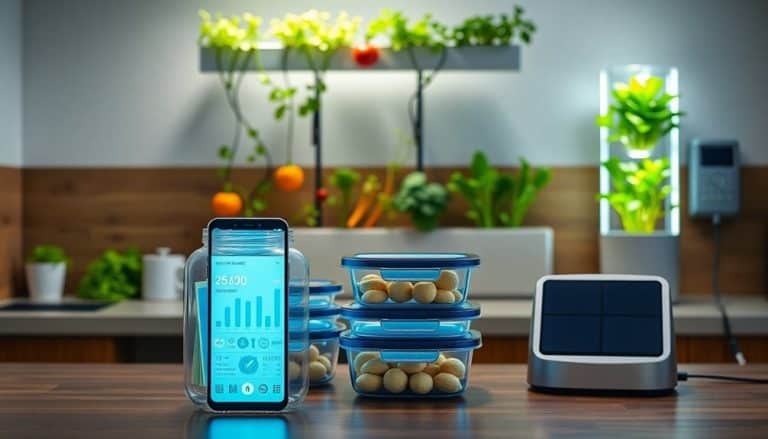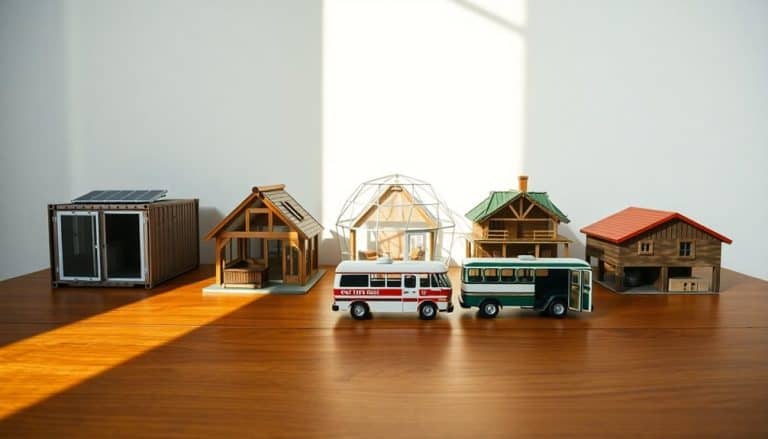This website contains affiliate links. Some products are gifted by the brand to test. As an Amazon Associate, I earn from qualifying purchases. The content on this website was created with the help of AI.
Start your minimalist journey in 2024 by focusing on three key areas: digital decluttering, physical spaces, and daily habits. Begin with your digital life by unsubscribing from unnecessary emails, organizing files, and deleting unused apps. Then tackle your physical spaces room by room, sorting items into keep, donate, sell, or trash categories. Create smart storage solutions with multi-purpose furniture and vertical organization systems. Adopt the one-in-one-out rule for new purchases, and simplify your routines with automated technology. As you implement these essential strategies, you’ll discover how a clutter-free environment leads to greater mental clarity and purposeful living.
Key Takeaways
- Start with digital decluttering by removing unused apps, organizing emails, and maintaining a minimalist approach to digital storage.
- Implement the one-in-one-out rule across all categories to prevent accumulation and maintain a balanced minimalist space.
- Create a capsule wardrobe of 30-40 versatile pieces focusing on neutral colors and high-quality items that serve multiple purposes.
- Tackle decluttering room-by-room using the four-category system: keep, donate, sell, and trash to maintain manageable progress.
- Streamline daily routines by identifying essential activities and using simple organizational systems with minimal technology complications.
Start With Your Digital Life
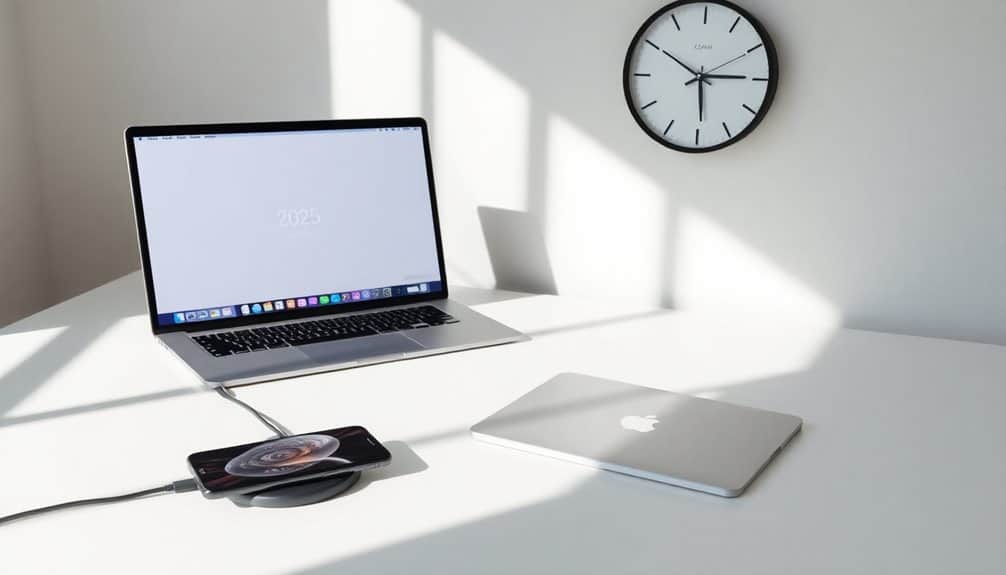
Three key areas make digital decluttering the perfect starting point for minimalist living: it’s less emotionally taxing than dealing with physical items, you can make significant progress quickly, and the results are immediately noticeable.
Start by tackling your email inbox. Unsubscribe from newsletters you don’t read, create folders for important messages, and delete unnecessary emails. Set up filters to automatically sort incoming mail, keeping your inbox lean and manageable.
Next, clean up your smartphone. Delete unused apps, organize remaining ones into folders, and clear your photo gallery of duplicates and blurry shots. Turn off non-essential notifications to reduce digital noise and maintain focus throughout your day.
Finally, streamline your computer. Remove old files, organize documents into a simple folder structure, and back up important data to the cloud. Delete downloaded files you no longer need, and empty your recycle bin. Maintain a clean desktop with only essential shortcuts.
Remember to establish new digital habits: deal with emails immediately, regularly delete unnecessary files, and think twice before downloading new apps or signing up for subscriptions.
Declutter One Room at Time
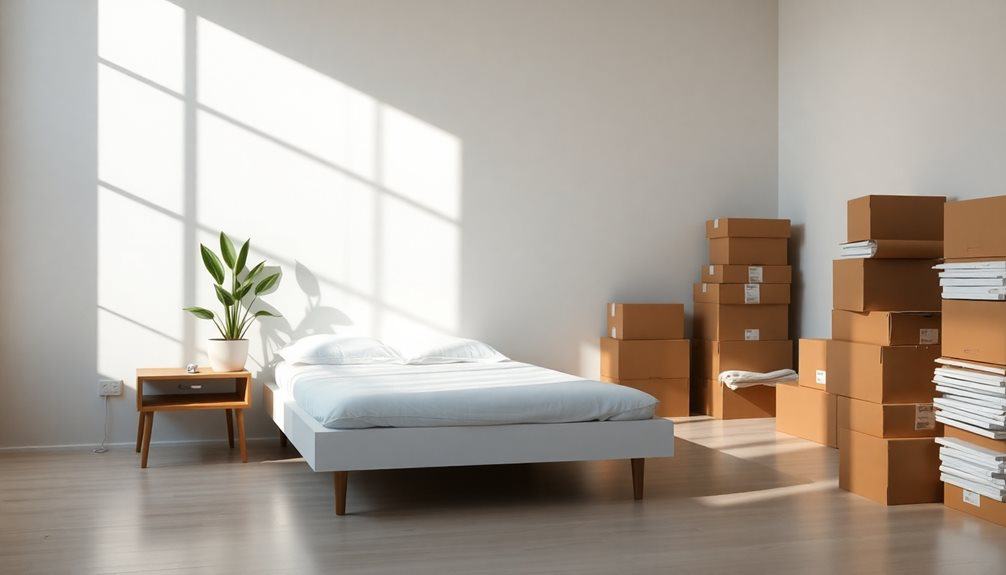
Moving from digital to physical decluttering can feel overwhelming, but tackling one room at a time makes the process manageable and less intimidating. Choose a room that’ll give you quick wins, like a bathroom or guest room, to build momentum and confidence before tackling more challenging spaces.
Start by removing everything from the room and sorting items into four categories: keep, donate, sell, and trash. Be ruthless with your decisions – if you haven’t used something in the past year, it’s likely you won’t need it. Test each item against two criteria: does it serve a practical purpose, and does it add value to your life?
When returning items to the room, assign specific zones for different activities and create organized storage solutions. Install hooks for hanging items, use clear containers for smaller objects, and implement the “one in, one out” rule to maintain the decluttered space. Don’t forget vertical storage options like shelving units or over-door organizers to maximize space. Consider adding 600D Oxford fabric storage organizers for their superior durability and weight capacity compared to standard materials. Once you’ve successfully decluttered one room, use that motivation to move onto the next space, applying the same systematic approach throughout your home.
Create Smart Storage Solutions
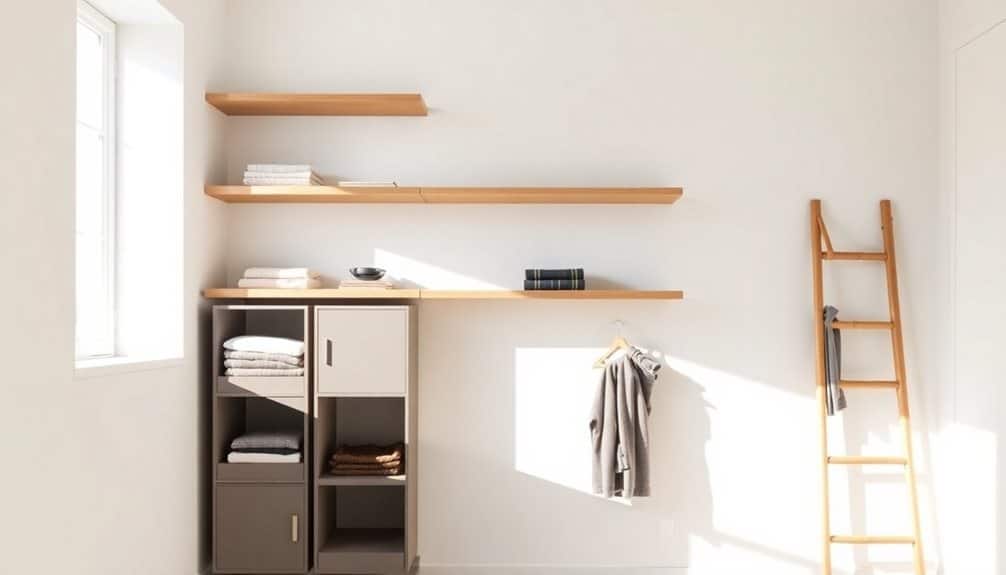
Beyond decluttering, smart storage solutions serve as the backbone of minimalist living. You’ll need to maximize your space while maintaining a clutter-free environment through strategic organization. Start by investing in multi-purpose furniture like ottoman storage beds, floating shelves, and modular units that adapt to your changing needs.
Install vertical storage systems to utilize wall space effectively. Mount hooks, pegboards, and magnetic strips to keep frequently used items accessible yet organized. In your closet, use slim hangers, drawer dividers, and stackable containers to optimize space. Consider installing pull-out cabinets in deep storage areas to prevent items from getting lost in the back.
Create designated zones for different categories of items, using clear containers for visibility and easy access. Label everything systematically to maintain order and prevent accumulation of unnecessary items. Under-bed storage containers work well for seasonal items, while door-mounted organizers maximize unused space. Remember to leave some empty space in each storage area – this prevents overcrowding and maintains the minimalist aesthetic. When selecting storage solutions, choose quality pieces that align with your home’s design and will last for years. For optimal organization in tight spaces, consider rolling file carts that feature 360-degree mobility and multiple tiers for efficient categorization.
Practice the One-In-One-Out Rule
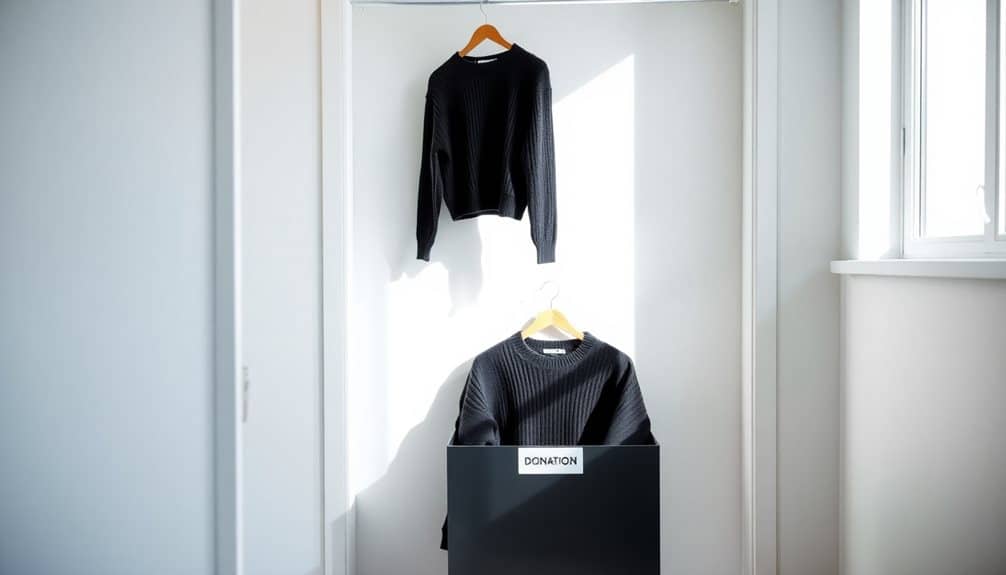
As a cornerstone of minimalist living, the one-in-one-out rule helps maintain a clutter-free lifestyle by establishing a simple principle: whenever you bring a new item into your home, remove an existing one.
Start by applying this rule to your wardrobe. When you purchase a new shirt, select an old one to donate or discard. This practice prevents clothing accumulation and maintains a manageable closet size. Extend this approach to books, electronics, kitchen items, and decorative pieces.
You’ll need to make thoughtful decisions before acquiring new items. Ask yourself if you truly need the new purchase and which existing item you’re willing to part with. This mindset shift helps curb impulse buying and promotes intentional consumption.
Keep track of your exchanges by maintaining a simple log or using a minimalist app. When removing items, decide whether to sell, donate, or dispose of them responsibly. Remember that the one-in-one-out rule isn’t just about maintaining equilibrium; it’s about curating a space filled only with items that serve a purpose or bring genuine joy to your life.
Consider using clear storage containers for organizing remaining items, as they help maintain minimalism by allowing you to quickly identify contents and prevent unnecessary duplicate purchases.
Embrace Sustainable Home Technology

Smart technology serves as a powerful ally in minimalist living, helping you reduce waste and optimize your home’s efficiency. Start by investing in a smart thermostat to automatically regulate your home’s temperature, reducing energy consumption and eliminating the need for multiple climate control devices. Install smart LED bulbs that you can control remotely, allowing you to manage lighting throughout your home from a single device.
Replace multiple remote controls with a smart home hub that connects your entertainment systems, speakers, and streaming services. You’ll declutter your space while gaining better control over your media. Consider a smart water monitoring system to track usage and detect leaks, preventing waste and costly repairs. Smart power strips can eliminate phantom energy drain from idle electronics, reducing both clutter and electricity bills.
Don’t overlook the power of smart storage solutions, like app-controlled organization systems that help you track what you own and need. These technologies not only simplify your life but also support your minimalist journey by providing data-driven insights about your consumption patterns and helping you make informed decisions about what to keep or eliminate.
Master the Art of Letting Go

Letting go of possessions represents the cornerstone of minimalist living, yet it’s often the most challenging aspect for beginners to master. You’ll need to develop a methodical approach to decluttering that addresses both physical items and emotional attachments.
Start by categorizing your belongings into four groups: keep, donate, sell, and discard. When evaluating each item, ask yourself: “Have I used this in the past year?” and “Does this truly add value to my life?” If you’re struggling with sentimental items, take photos before parting with them to preserve the memories without keeping the physical objects.
Set specific decluttering goals with deadlines. You might target one room per week or commit to removing ten items daily. Don’t rush the process – meaningful minimalism develops gradually. Create a “maybe” box for items you’re unsure about, and if you haven’t needed them after 90 days, let them go without opening the box.
Remember that letting go extends beyond physical possessions. Release outdated habits, toxic relationships, and time commitments that don’t align with your minimalist journey. You’ll find that fewer possessions lead to greater mental clarity and purposeful living. Consider starting a garden compost bin and use quality sifters to transform waste into purposeful resources.
Design a Capsule Wardrobe
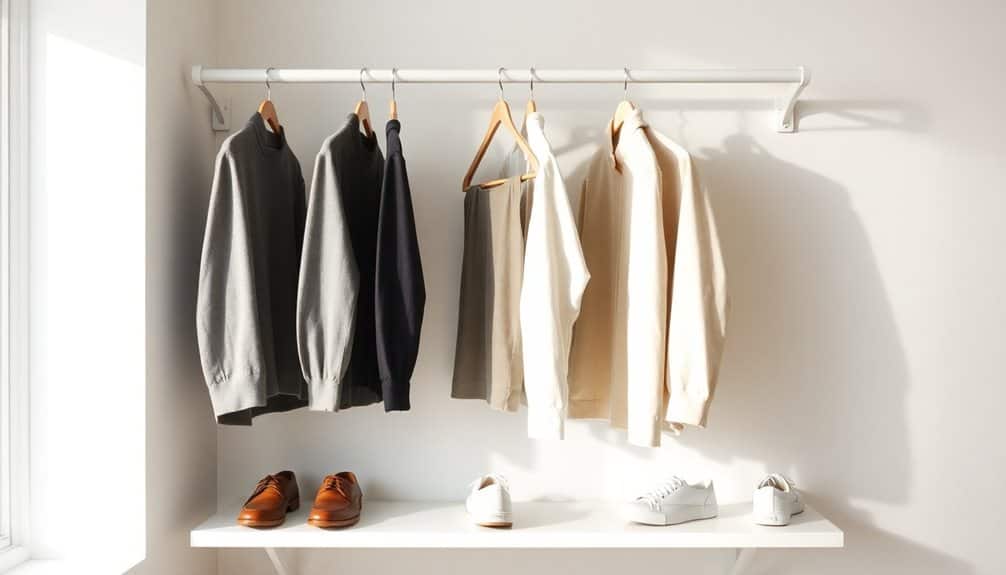
Creating a capsule wardrobe frequently serves as the first practical step toward minimalist fashion. You’ll need to start by selecting a color palette that works with your lifestyle and preferences, typically focusing on neutral colors that mix and match easily.
Begin by evaluating your current wardrobe and identifying the pieces you wear most often. Keep versatile items that can create multiple outfits and remove anything that doesn’t fit, feels uncomfortable, or hasn’t been worn in the past year. Your capsule wardrobe should include essential pieces like well-fitted jeans, basic t-shirts, a blazer, and versatile dresses.
Focus on quality over quantity when building your collection. Invest in durable pieces that’ll last longer and maintain their appearance through multiple washes. Aim for 30-40 items total, including shoes and outerwear. You’ll want to select items that can shift between seasons and occasions.
Don’t forget to reflect on your lifestyle needs when curating your capsule. If you work in a corporate environment, include more formal pieces. If you’re active, incorporate athleisure items that serve multiple purposes. Remember, your capsule wardrobe should reflect your personal style while maintaining functionality.
Simplify Your Daily Routines

Just as streamlining your wardrobe brings clarity to your closet, simplifying your daily routines can transform your entire day. Start by identifying your three most essential morning activities and allocate specific time blocks for each. You’ll find that a structured morning routine eliminates decision fatigue and sets a productive tone for the day ahead.
Create standardized processes for recurring tasks. Set up autopay for bills, prep meals in batches, and establish designated spots for everyday items like keys and devices. When you don’t waste time searching for misplaced items or making repetitive decisions, you’ll reclaim valuable mental energy.
Leverage technology thoughtfully to automate routines. Use smart home devices to regulate lighting and temperature, schedule regular grocery deliveries, and maintain digital calendars for appointments. However, avoid overcomplicating systems with too many apps or notifications. Installing wall-mounted hooks near your entryway creates an organized drop zone for backpacks and everyday essentials.
Find Your Minimalist Style
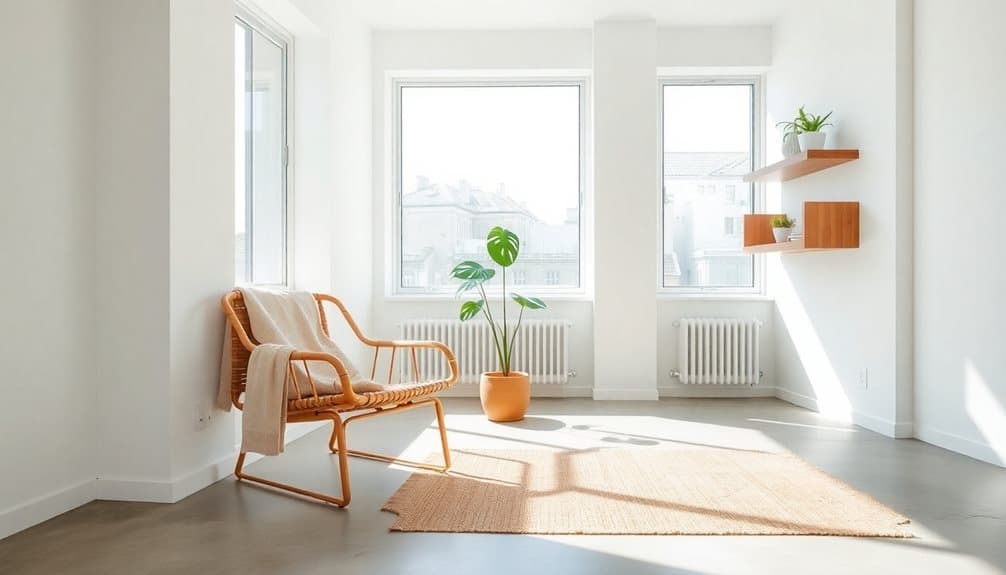
Minimalist style isn’t a one-size-fits-all approach to living with less. Your version of minimalism should reflect your values, lifestyle, and personal preferences while maintaining the core principle of intentional living.
Start by identifying your priorities and non-negotiables. If you’re a tech enthusiast, your minimalist style might include the latest gadgets while cutting back on physical books. If you’re an artist, you’ll likely keep your creative supplies while minimizing other areas of your life.
Consider your aesthetic preferences. Minimalism doesn’t mean stark white walls and empty spaces unless that’s what you prefer. You can embrace warm colors, textures, and meaningful decorative pieces while still maintaining a clutter-free environment.
Experiment with different minimalist approaches. Try capsule wardrobes, digital decluttering, or room-by-room simplification to discover what works for you. Pay attention to how each change affects your daily life and emotional well-being.
Remember that your minimalist style can evolve. As your life circumstances change, allow your interpretation of minimalism to adapt while keeping its core benefits: reduced stress, increased clarity, and more time for what truly matters.
Frequently Asked Questions
How Do Minimalists Maintain Relationships With People Who Don’t Share Their Lifestyle?
You can maintain healthy relationships with non-minimalists by focusing on shared values and experiences rather than lifestyle differences. Don’t judge or lecture others about their choices, and be open to socializing in ways that work for both parties. Set boundaries when needed, like suggesting activity-based gatherings instead of gift exchanges. Remember that relationships aren’t about possessions but about genuine connections and mutual respect.
What Financial Benefits Can I Expect From Adopting Minimalism?
Studies show that the average American spends $18,000 per year on non-essential items. You’ll save considerably by embracing minimalism through reduced impulse buying, lower housing costs, and decreased storage expenses. You’ll also spend less on maintenance and insurance, while gaining better clarity over your finances. Additionally, you’ll earn extra cash by selling unused items and avoiding unnecessary subscriptions, leading to more mindful spending habits.
How Do I Handle Gifts From Family Members Without Compromising Minimalist Values?
You can handle gifts gracefully while maintaining minimalist values by communicating your preferences openly with family members. Suggest experiences, consumables, or practical items you’ll actually use. Create a wishlist to guide their choices, or request contributions to experiences or savings goals. If you receive unwanted gifts, donate them thoughtfully or repurpose them. Remember, it’s okay to politely decline items while showing appreciation for the gesture.
Can Minimalism Work in Households With Young Children or Pets?
Yes, you can practice minimalism with kids and pets, but you’ll need to be flexible and realistic. Focus on rotating toys instead of having everything out at once, establish regular decluttering routines, and teach children about mindful consumption. For pets, keep essentials organized in designated zones, opt for quality over quantity with supplies, and regularly assess what they actually use versus what you’ve accumulated.
Should I Tell My Roommates About Switching to Minimalism Before Starting?
Like ripples in a pond, your lifestyle changes will affect those around you. You should definitely talk to your roommates about your minimalist journey beforehand. It’s respectful to discuss shared spaces and communal items since your decisions might impact them too. Set clear boundaries about personal vs. shared items, and be open to compromise. You might even inspire them to join you in decluttering.



